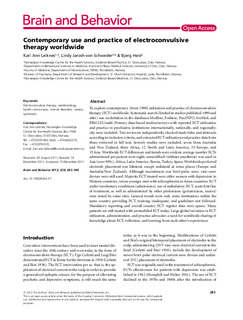| dc.description.abstract | To explore contemporary (from 1990) utilization and practice of electroconvulsive therapy (ECT) worldwide. Systematic search (limited to studies published 1990 and after) was undertaken in the databases Medline, Embase, PsycINFO, SveMed, and EBSCO/Cinahl. Primary data-based studies/surveys with reported ECT utilization and practice in psychiatric institutions internationally, nationally, and regionally; city were included. Two reviewers independently checked study titles and abstracts according to inclusion criteria, and extracted ECT utilization and practice data from those retrieved in full text. Seventy studies were included, seven from Australia and New Zealand, three Africa, 12 North and Latin America, 33 Europe, and 15 Asia. Worldwide ECT differences and trends were evident, average number ECTs administered per patient were eight; unmodified (without anesthesia) was used in Asia (over 90%), Africa, Latin America, Russia, Turkey, Spain. Worldwide preferred electrode placement was bilateral, except unilateral at some places (Europe and Australia/New Zealand). Although mainstream was brief-pulse wave, sine-wave devices were still used. Majority ECT treated were older women with depression in Western countries, versus younger men with schizophrenia in Asian countries. ECT under involuntary conditions (admissions), use of ambulatory-ECT, acute first line of treatment, as well as administered by other professions (geriatricians, nurses) were noted by some sites. General trends were only some institutions within the same country providing ECT, training inadequate, and guidelines not followed. Mandatory reporting and overall country ECT register data were sparse. Many patients are still treated with unmodified ECT today. Large global variation in ECT utilization, administration, and practice advocates a need for worldwide sharing of knowledge about ECT, reflection, and learning from each other's experiences. | nb_NO |

